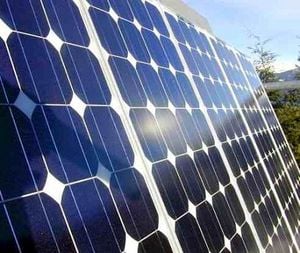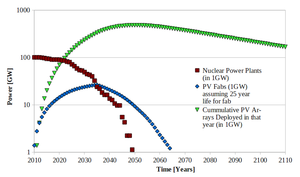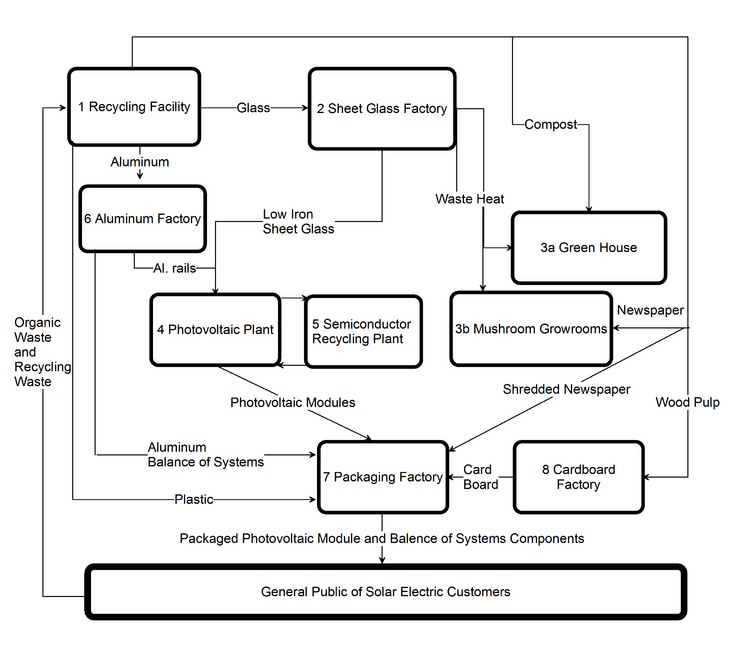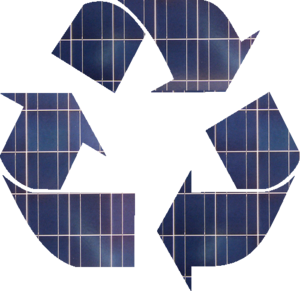
This page is a list of research projects, papers and literature reviews on photovoltaics.
LCA of silicon PV panels[edit | edit source]

Alternative energy technologies such as photovoltaic modules (Figure 1) are becoming more popular around the world. In 2008, for the first time, worldwide investments in alternative energy sources drew more investors than fossil fuels, netting $155 billion in net capital against $110 billion of new investment in oil, natural gas and coal. Solar power alone generated $6.5 billion in worldwide revenue in 2004, and is expected to almost triple that with projected revenues of $18.5 billion for 2010.
Alternative energy technologies are becoming increasingly popular throughout the world due to greater awareness and concerns regarding pollution, and global climate change. Alternative energy technologies offer a new option for obtaining useful energy from sources that have less environmental impact on the planet. But how much less?
A previous published review of the net energy analysis of silicon-based photovoltaics[1] found that all types of silicon (amorphous, polycrystalline and single crystal)-based PV generated far more energy over their lifetime than is used in their production. All modern silicon PV pay for themselves in terms of energy in less than 5 years - even in highly suboptimal deployment scenarios.
This article explores all of the environmental impacts associated with the production and lifetime use of silicon photovoltaic (PV) panels.
An open source simulation of photovoltaic yield with r.sun over large regions[edit | edit source]

This is an investigation of the capacity and capabilities of the module r.sun, one of the utilities of the Geographical Resources Analysis Support System (GRASS). Using Southeastern Ontario as case study, insolation, including temporal and spatial variation of albedo, was computed to output reliable solar energy for large scale solar PV farm development in the region.
Full text of study available here: H.T. Nguyen and J.M. Pearce, "Estimating Potential Photovoltaic Yield with r.sun and the Open Source Geographical Resources Analysis Support System" Solar Energy 84, pp. 831-843, 2010. open access
Optimizing limited solar roof access by exergy analysis of solar thermal, photovoltaic, and hybrid photovoltaic thermal systems[edit | edit source]
When trying to decide what type of renewable energy makes the most sense for a given application - thermodynamics should be our guide. Specifically, exergy is the energy that is available to be used - the useful energy and should be the figure of merit. In this paper we compare three types of solar energy systems using exergy to draw some generalizable conclusions for solar in the U.S.
Diverting indirect subsidies from the nuclear to the photovoltaic industry: Energy and financial returns[edit | edit source]

As energy demands continue to grow, so too does the debate over the future of energy supply. As such, nuclear technology is often pitted against renewable sources such as solar photovoltaic (PV) technology through comparisons of energy capacity, life cycle, GHG emissions and economic performance. The economic arguments in particular are distorted and heavily defined by subsidies to nuclear industry - these can be in the form of direct and indirect subsidies. Our focus was to evaluate the effects of indirect subsidies - such as the nuclear insurance liability subsidy, and compare energy returns if a subsidy of the same magnitude was diverted instead to the solar photovoltaic industry.
Effects of low concentration planer concentrators on array-scale solar photovoltaic systems performance[edit | edit source]

This project will investigate the effects on yearly performance of a planer concentrator on array-scale solar photovoltaic (PV) installations. Planer concentrators for thermal collectors have been studied extensively and have been found to substantially increase energy yield. Some studies have looked at planer concentrators applied to PV systems and analyzed optimal reflector and panel angles to maximize insolation increase. These studies showed theoretical and experimental performance increases by 20 to 30%. However, to date, the loss mechanisms associated with these systems have not been fully understood, and work must be done to determine how low concentration systems can be optimized to account for such losses.
Implementation of solar PV for grid-tied power generation applications is increasing at a rapid pace (approximately 40% growth year of year) as recognition that this technology can provide an abundant and environmentally friendly energy source. At the moment the pattern of implementation of PV is at a variety of latitudes which are not necessarily the ideal equatorial regions where solar resource is maximized. In fact, over 70% of PV installed globally in 2010 was done at latitudes greater than 40⁰.
At these latitudes, a conventional fixed-tilt PV array consists of multiple east-west rows containing southern facing PV panels. To minimize row-to-row shading during periods of low solar altitude (morning and night), these rows are spaced in the north-south direction. However, at times with the greatest solar potential (solar noon), this row spacing is illuminated and the energy is not fully utilized. Planer concentrators allow this unused energy to be captured by the PV panels.
We have made a theoretical framework for modeling a planar concentrator on an array scale PV installation. This model thoroughly accounts for loss mechanisms in this system including thermal, angle of incidence, reflectivity and string mismatch in order to allow for informed design of low concentration PV systems. Using this model, a case study in Canada was performed and the simulation results show that a planar reflector system installed on a traditional crystalline-silicon PV farm can produce increases in electrical yield from 23%-34%.[2]
Our aim is to conduct further experimental work, at the Sustainable Energy Applied Research Centre (SEARC), a state of the art outdoors test facility and one of the premier PV test beds in North America, to prove the accuracy of the model. The experimental work will look into the loss mechanism and how to optimize power output accounting for them, in both crystalline and amorphous silicon PV panels. Finally, because of the detailed temperature monitoring of the panels under concentration this study hopes to not only verify the model and improve PV performance but also provide the data necessary to have the warranty voiding clauses removed for low concentration from silicon-based PV modules.
Effects of snow on photovoltaic performance[edit | edit source]
Photovoltaic solar cell systems represent one of the most promising means of maintaining our energy intensive standards of living.[3] open access With Canada, and Ontario in particular, concentrating a much larger focus on photovoltaic development, there is a keen interest and concern in the effects of snow cover on solar energy yield. From small scale residential to large multi-MW ventures, developers are interested in the effect of snow on the performance of different types of panels and on the optimization of racking angles. There have been very few comprehensive studies performed which attempt to quantify the effects of snowfall, and none which provide universally applicable estimations of snow related losses. Thus, the first goal of this study is to attempt to gain a better understanding of the effects of snowfall on PV performance, and to provide some recommendations for reducing these losses.
In response to this, a project has been initiated to investigate the practical performance of commercial PV panels in the Ontario climate. As such a large outdoors test site is being commissioned as a collaboration between the Queen's Applied Sustainability Group (ASG) and St. Lawrence Sustainable Energy Applied Research Centre (SEARC) in order to provide highly accurate and practical data on PV performance year round. This site is being used in addition to the Queen's Innovation Park test site originally commissined by Queen's Applied Sustainability group and sponsored by Sustainable Energy Technologies Beyond providing practical information to industry and a test platform for advanced PV system design research the system will also be integrated into the curriculum of the ESAT program St.Lawrence College, helping to train the next generation of PV installers and developers.
The data collected from this project will lead the development of a model which will predict the annual losses due to snowfall for arrays set at a variety of angles. This information will allow developers to make more informed decisions when installing photovoltaic arrays in northern climates. In addition, testing capabilities being developed can be applied to future practical outdoors evaluations of panel performance.
Estimating the rooftop PV potential of a large-scale geographical region[edit | edit source]
In many studies, scientists have determined methods of obtaining of Building-Integrated Photovoltaic (BIPV) potential as a function of the available roof area. However, the roof area is typically left as a variable, as there is no direct roof area data available in most regions of the world. Various modelling techniques can determine available roof area for a sample consisting of a few buildings, or perhaps a university campus. However, to estimate BIPV potential for a large region, these techniques are too labour-intensive. It is thought, however, that this information can be approximated on a large scale using data on urban area, building and population density, in combination with analysis of air photos or satellite images of urban regions.
This has been completed by Izquierdo, Rodrigues and Fueyo at the University of Zaragoza and LITEC in Spain (article available below). The purpose of this research is to attempt to customize their methodology to be applied to the South Eastern Region of Ontario, Canada. Visual Learning Systems's Feature Analyst GIS extension will be used.
This work is being done in conjunction with the Queen's Institute for Energy and Environment Policy.
Technical Solar Photovoltaic Potential of Scaled Parking Lot Canopies- A Case Study of Walmart U.S.A.[edit | edit source]

Solar photovoltaic (PV) technology can provide sustainable power for the growing global population in cities, but it demands considerable land area. This is a challenge for densely populated cities. However, the stranded assets of non-productive parking lots areas can be converted to solar farms with PV canopies, enabling sustainable electricity generation while preserving their function to park automobiles. This study provides a method for determining the technical and economic potential for converting a national scale retail company's parking lot area to a solar farm. First, the parking lot area for the company is determined and divided into zones based upon solar flux using virtual maps. Then the potential PV yield in each zone is calculated. A sensitivity analysis is performed on the price per unit power installed, solar energy production as a proxy for conversion efficiency, electricity rates and revenue earned per unit area. To demonstrate this method, analysis of Walmart Supercenters, USA is presented as a case study. The results show solar canopies for parking lot areas are a profitable as well a responsible step in most locations and there is significant potential for sustainable energy deployment in cities by other similar retailers using solar PV canopies.
The Potential for Grid Defection of Small and Medium Sized Enterprises Using Solar Photovoltaic, Battery and Generator Hybrid Systems[edit | edit source]

Grid-tied solar photovoltaic (PV) systems enable lower cost electricity for small and medium size enterprises (SMEs) than they are currently paying for grid electricity in the U.S. These economic realities threaten conventional electric utilities, which have begun manipulating rate structures to reduce the profitability of distributed generation (DG), as well as putting arbitrary caps on DG in their service territories. SMEs may reduce electricity costs, if they can grid defect with hybrid captive power systems made up of solar, battery and generator subsystems. This paper analyzes the technical and economic viability for hybrid solar systems deployed in the commercial sector to enable self-generation. Specifically, for the first time, the economics of grid defection are analyzed for three case studies of SMEs in the northern U.S., which represent a challenging technical case because of long dark winters, but also have high utility costs. The results of the simulations make it clear that grid defection is already viable for SMEs with the current prices for all components in the solar hybrid system. These results were consistent across scale, load-profile, and utility rate. These economic projections included no government incentives or subsidies and can thus be considered extremely conservative for the specific case studies. Policy changes are discussed for electric utilities to avoid the potential of a utility death spiral in this and similar performing locations.
Government support of photovoltaic manufacturing[edit | edit source]
Full title: Financial Return for Government Support of Large-Scale Thin-Film Solar Photovoltaic Manufacturing in Canada.
Abstract: As the Ontario government has recognized that solar photovoltaic (PV) energy conversion is a solution to satisfying society's energy demands while reducing the adverse anthropogenic impacts on the global environment that compromise social welfare, they have begun to generate policy and funding programs to support financial incentives for PV. This paper (publication below) provides a financial analysis for investment in a 1 GW per year turnkey amorphous silicon PV manufacturing plant. The financial benefits for both the provincial and federal governments were quantified for: i) full construction subsidy, ii) construction subsidy and sale, iii) partially subsidize construction, iv) a publicly owned plant, v) loan guarantee for construction, and vi) an income tax holiday. Revenues for the governments are derived from: taxation (personal, corporate, and sales), sales of panels in Ontario, and saved health, environmental and economic costs associated with offsetting coal-fired electricity. Both governments enjoyed positive cash flows from these investments in less than 12 years and in many of the scenarios both governments earned well over 8% on investments from 100s of millions to $2.4 billion. The results showed that it is in the financial best interest of both the Ontario and Canadian federal governments to implement aggressive fiscal policy to support large-scale PV manufacturing.
Source: K. Branker and J. M. Pearce, "Financial Return for Government Support of Large-Scale Thin-Film Solar Photovoltaic Manufacturing in Canada", Energy Policy 38, pp. 4291–4303 (2010). Open access
Industrial symbiosis in photovoltaic manufacturing[edit | edit source]
Solar photovoltaic (PV) cells offer a technically sustainable solution to the projected enormous future energy demands. This project explores utilizing industrial symbiosis to obtain economies of scale and increased manufacturing efficiencies for solar PV cells in order for solar electricity to compete economically with fossil fuel-fired electricity.

The eco-industrial park has been designed to be made up of at least 8 symbiotic factories as seen in Fig. 1:[4]
- Conventional recycling facility
- Sheet glass factory
- a) greenhouse or b) mushroom growroom
- the photovoltaic plant
- semiconductor recycling plant
- Aluminum factory
- Packaging plant
- Cardboard factory
The study[4] open access found that by co-locating these factories in the eco-industrial park, the transportation costs and energy between them can be minimized and many of the inputs for the solar PV plant can literally come from waste products in the surrounding population centers. It should be noted that each factory will be scaled appropriately for the symbiotic system and should be individually profitable so that independent businesses can replicate this model by co-locating and benefit from industrial symbiosis in future facilities.
This study was then built upon by looking specifically at the relationship between (1) the recycling facility and (2) the glass factory to provide the necessary substrate glass for (3) the PV factory.[5]This article quantified the inputs and outputs for the glass manufacturing component of such a system using standard manufacturing techniques and found that utilizing industrial symbiosis in this way, potential reductions for such a plant were found to be about 30,000 tons/year in raw materials and over 220,000 GJ/year in embodied energy.[5]
Leveraging solar photovoltaic technology for sustainable development in Ontario's aboriginal communities[edit | edit source]

The Ontario feed-in tariff (FIT) for solar photovoltaic (PV) technology has provided Ontario's Aboriginal communities with an opportunity to i) weaken the cycle of poverty; ii) directly counteract climate change by producing renewable energy; and iii) become more self-sufficient. This paper critically analyzes the technical, cultural, and economic viability of leveraging the FIT for PV to provide green electricity and revenue to assist First Nations communities in sustainable development. A generalized free GIS-energy-based protocol was developed to determine the PV potential for Aboriginal communities. This model was applied to a case study of the Constance Lake First Nations community and an economic analysis showed financially-viable rates of return over 20 years. By generalizing these findings to Ontario, the potential PV deployment on First Nation rooftops alone is over 200MW, which clearly provides an opportunity for developing pride associated with owning a community-led, environmentally beneficial, local energy project.
Producer responsibility and recycling solar photovoltaic modules[edit | edit source]

Rapid expansion of the solar photovoltaic (PV) industry is quickly causing solar to play a growing importance in the energy mix of the world. Over the full life cycle, although to a smaller degree than traditional energy sources, PV also creates solid waste. This paper examines the potential need for PV recycling policies by analyzing existing recycling protocols for the five major types of commercialized PV materials. The amount of recoverable semiconductor material and glass in a 1 m2 area solar module for the five types of cells is quantified both physically and the profit potential of recycling is determined. The cost of landfill disposal of the whole solar module, including the glass and semiconductor was also determined for each type of solar module. It was found that the economic motivation to recycle most PV modules is unfavorable without appropriate policies. Results are discussed on the need to regulate for appropriate energy and environmental policy in the PV manufacturing industry particularly for PV containing hazardous materials. The results demonstrate the need to encourage producer responsibility not only in the PV manufacturing sector but also in the entire energy industry.
McDonald, N.C., and J.M. Pearce. "Producer responsibility and recycling solar photovoltaic modules". Energy Policy 38(11) (2010): 7041-7047. QSpace pre-print open access
Hybrid photovoltaic-trigeneration systems[edit | edit source]
Recent work has proposed that hybridization of residential-scale cogeneration with roof-mounted solar PV (photovoltaic) arrays can increase the PV penetration level in ideal situations by a factor of five. In regions where there is a significant cooling load PV-cogen hybrid systems could be coupled to an absorption chiller to utilize waste heat from the cogen unit. In order to investigate realistic (non-ideal) loads that such a hybrid system would need to service, a new numerical simulation called PVTOM (PV-trigeneration optimization model) was created and coupled to the results of the established CHREM (Canadian Hybrid Residential End-Use Energy and Emissions Model). In this paper, PVTOM is applied to representative houses in select Canadian regions, which experience cooling loads, to assess the fuel utilization efficiency and reduction in greenhouse gas emissions from hybrid PV-cogen and trigen systems in comparison with conventional systems. Results of the optimization runs are provided and the efficacy of PV-cogen and PV-trigen systems is discussed. Both PV-trigen and PV-cogen systems have demonstrated to be more effective at reducing emissions when compared to the current combination of centralized power plants and household heating technologies in some regions.
- A.H. Nosrat, L.G. Swan, J.M. Pearce, "Improved Performance of Hybrid Photovoltaic-Trigeneration Systems Over Photovoltaic-Cogen Systems Including Effects of Battery Storage", Energy 49, pp. 366-374 (2013). DOI, open access.
Collections[edit | edit source]
Literature reviews[edit | edit source]
- Deployment of Renewable Energy Technologies to Mitigate Climate Change Literature Review
- Optimizing limited solar roof access by exergy analysis of solar thermal, photovoltaic, and hybrid photovoltaic thermal systems/Literature review
- Government Investment and PV Manufacturing - Lit. Review
- Government PV Manufacturing Policy Lit Review
- Government PV Manufacturing Policy Lit Review
- InGaN solar cells literature review
- Levelised Cost of Electricity Literature Review
- Lifespan and Reliability of Solar Photovoltaics - Literature Review
- Low level concentration for PV applications literature review
- PV and CHP Literature review
- PV penetration level Literature review
- Peer to Peer Lending and Microfinance for Solar - Lit. Review
- Regional Rooftop Solar Photovoltaic Potential Literature Review
- Spectral Selective Coatings Literature Review
- Transport PV - Lit Review
- Troubleshooting a PV System - Literature Review
References[edit | edit source]
- ↑ J. Pearce and A. Lau, "Net Energy Analysis For Sustainable Energy Production From Silicon Based Solar Cells", Proceedings of American Society of Mechanical Engineers Solar 2002: Sunrise on the Reliable Energy Economy, editor R. Cambell-Howe, 2002.pdf
- ↑ Rob Andrews, Nabeil Alazzam, and Joshua M. Pearce, "Model of Loss Mechanisms for Low Optical Concentration on Solar Photovoltaic Arrays with Planar Reflectors", 40th American Solar Energy Society National Solar Conference Proceedings, pp. 446-453 (2011). free and open access
- ↑ J. M. Pearce, Photovoltaics - A Path to Sustainable Futures, Futures 34 (7), 663-674, 2002
- ↑ 4.0 4.1 Joshua M. Pearce, "Industrial Symbiosis for Very Large Scale Photovoltaic Manufacturing", Renewable Energy 33, pp. 1101–1108, 2008. http://dx.doi.org/10.1016/j.renene.2007.07.002 Open access [1]
- ↑ 5.0 5.1 Amir H. Nosrat, Jack Jeswiet, and Joshua M. Pearce, "Cleaner Production via Industrial Symbiosis in Glass and Large-Scale Solar Photovoltaic Manufacturing" open access, Science and Technology for Humanity (TIC-STH), 2009 IEEE Toronto International Conference, pp.967-970, 26-27 Sept. 2009. open access